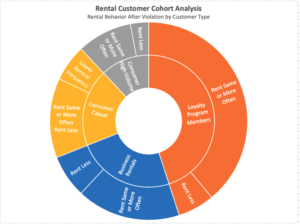Database Discovery is an extension to the traditional e-discovery approach using enterprise business data as a source of insight. Rather than limit yourself to documents, emails, and text messages in your discovery practice, you can add transactional data from enterprise systems like Salesforce, Oracle, SAP, Concur, and more. Read on for more details on a specific case where database discovery was pivotal in forming a defense argument.
Class-Action Suit: Rental Car Company
A well-known rental car company followed the practice of automatically charging their customers for any traffic citations they received while using the rental car. A class action suit was filed, challenging the practice and suggesting that it harmed the driver by automatically admitting guilt and removing his/her ability to contest the violation. With compensatory damages alleged, the defendant was facing a potential loss in the high tens of millions of dollars. A critical question from the defense: if the class members found the violation payment so objectionable, did they continue to rent from the company? What do our business records tell us about the behavior of class members after receiving and paying such a fine?
Solution: With the help from Sapling Data, the legal team was able to reconstruct behavior models of the class members. That analysis showed that customers who received citations and subsequent charges from the company had a very similar repeat rental rate as customers who did not get a citation. In short, a great majority of class members demonstrated with their own behavior that the harm they incurred was so minor that it did not even prompt them to use a different rental car company.
The approach required a number of common steps from the database discovery model:
- Integrating Data from Multiple System Sources
- Modeling Customer Behavior
- Customer Cohort Analysis to build class segments based on a variety of attributes
A simplified view of the customer cohort analysis is shown in the pie chart below. By understanding the behavioral patterns of the customers, as described by hundreds of thousands of data records, the legal team was able to form a strongly-supported argument to minimize risk.

To learn more about this case and others where Database Discovery was employed, download our White Paper entitled: “Database Discovery: Extend Traditional E-Discovery with Enterprise Business Data.”
Sapling Data has more than 8 years experience building data analytics solutions and tools. Our Database Discovery platform enables legal and compliance teams to build a consolidated, cloud-based data warehouse for monitoring, investigation, and reporting needs.